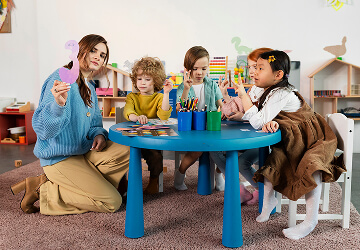By: Rima Gandhi, M.S., OTR/L
Sensory Processing:
Sensory Processing (Sensory Integration) is a complex neurobiological process in which sensory information is effectively perceived, registered, and integrated by the brain and body for functional behavior. Put simply, sensory processing is the ability to integrate and respond to sensory input in a meaningful and consistent manner. For example, if your tactile (touch) system receives cold input on the skin, your brain will process the input and will prompt a meaningful action – in this case, putting on a jacket.
Why is Sensory Processing Important?
Sensory processing is crucial because it helps the brain interpret and respond to the world around us. It allows us to process information from our senses – sight, sound, touch, taste, smell, movement, and body awareness. Proper sensory processing enables:
- Self-Regulation – Helps manage emotions, attention, and behavior
- Motor Skills & Coordination – Essential for balance, movement, and fine motor tasks like writing or buttoning a shirt.
- Social Interaction – Supports communication, recognizing social cues, and engaging with others.
- Learning & Development – Impacts focus, problem-solving, and academic skills.
- Safety & Awareness – Helps recognize dangers, such as sensing pain or avoiding obstacles.
When sensory processing is disrupted – as is the case with Sensory Processing Disorder or neurodivergent conditions such as Autism – daily activities can become overwhelming and challenging. Supporting sensory needs, through sensory regulation techniques and strategies, can improve well-being, comfort, and participation in life’s daily activities.
Building Blocks of the Sensory System:
The sensory system is built on several key components, each responsible for processing different types of sensory input. These building blocks include:
- Auditory System (Hearing)
- Visual System (Sight)
- Olfactory System (Smell)
- Gustatory System (Taste)
- Tactile System (Touch)
- Vestibular System (Movement)
- Proprioceptive System (Body Awareness)
- Interoceptive System (Internal Body Signals)
Each of these systems work together to help us navigate and interact with the world efficiently. If any system is not functioning optimally, it can affect daily activities, emotional regulation, and overall wellbeing.
Sensory Processing Challenges
Sensory processing challenges occur when the sensory information from one or more sensory system is not effectively perceived, registered, and integrated by the body and the brain for functional behavior. Maladaptive behaviors and responses may occur due to overstimulation or diminished stimulation, which can impact participation in daily life.
A child will primarily fall into one of the two categories: Sensory Seekers (also known as Sensory Under Responsive, or SUR) or Sensory Avoidants (Sensory Over Responsive, or SOR). Children may exhibit signs of both, however, one of these patterns typically predominates.
How Do You Know If A Child Exhibits Sensory Processing Difficulties?
If a child has difficulty with sensory processing, you may see some of these signs:
Sensory Seekers:
- Being overactive
- Watching as others move around the room
- Constantly touching people or objects
- Being unable to sit still
- Constantly being on the go
- Jumping, spinning, or rocking
- Fidgeting with anything within reach
- Frequently picking at fingers
- Taking risks on the playground
- Falling on purpose without regard to safety
- Seeking to smell both food/non-food items
- Mouthing non-food items
- Under reactive to stimuli (ie. high pain
threshold) - Poor Motor Skills – appears “clumsy”
- Asks constantly for “hugs” or “squeezes”
Sensory Avoidants:
- Heightened reactivity to sight, sound, and movement
- Picky eater
- Avoids certain textures or fabrics
- Avoids physical touch – ie. hugs
- Can have heightened anxiety
- Avoids excessive movement ie. swinging spinning
- Difficulty engaging in playground equipment
- Covers ears
- Shies away from bright lights or visually stimulating areas
- Likes quiet and avoids crowds
What Can Be Done To Help With Sensory Challenges:
- Become a SENSORY DETECTIVE! Understanding the sensory systems that are challenging for the child is IMPORTANT in intervention and modification of the environment.
- Work with a Sensory Integration (SI) trained Occupational Therapist to help correctly assess and determine specific areas of challenges and formulate an intervention plan.
- Environmental Modifications: Based on the sensory assessment, modify the environment to suit the child’s needs to help increase overall wellbeing and participation. Learn more about creating inclusive spaces HERE!
- Sensory Diet: Formulate a sensory diet to provide sensory feedback to the body for efficient sensory regulation.
Insight:
It is important to remember that our sensory system is uniquely ours. It makes us who we are. After all, we are ALL sensory beings, and it is how we interact with the world around us. A child with specific sensory challenges is NO different! Their sensory uniqueness should be acknowledged and not dismissed or extinguished!
By being a sensory detective and understanding their sensory needs, we can provide inclusive spaces for these children to feel more comfortable and to be their UNIQUE self!
